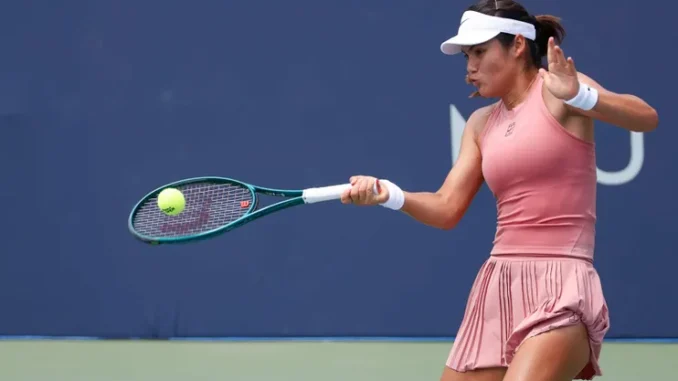
In the unforgiving arena of professional tennis, where every forehand carries the weight of a career-defining moment, Emma Raducanu stands once again at a critical juncture. The 22-year-old British star, forever etched in history as the 2021 US Open champion who stunned the world as a qualifier at just 18, is now tasked with navigating a treacherous path at the Ningbo Open. This WTA 500 tournament, set to ignite the hard courts of China’s vibrant coastal city from October 13 to 19, 2025, offers both a stage for redemption and a crucible of challenges. Raducanu’s draw is a gauntlet: an opening clash against hometown favorite Lin Zhu, followed by the looming specter of a second-round duel with world No. 5 Mirra Andreeva. As the tennis world watches, the question looms large—can Raducanu harness the magic of her Grand Slam past to fuel a late-season resurgence, or will the scars of recent health struggles dim her star once more?
Raducanu’s journey to Ningbo has been a rollercoaster of dazzling highs and crushing lows, her career a tapestry woven with threads of brilliance and frayed by persistent injuries and environmental extremes. Just days ago, at the WTA 1000 Wuhan Open, she faced a punishing ordeal that underscored her vulnerability. Under a relentless sun, with temperatures soaring and humidity suffocating, Raducanu battled American Ann Li in her first-round match. Down 6-1, 4-1, her game unraveled—her fluid movement stifled, her shots misfiring. A medical timeout revealed troubling signs: elevated temperature, erratic blood pressure, and a creeping dizziness that forced her to retire after 70 minutes. From a Wuhan hospital bed, she shared a raw update on social media: “Last day at the doctor’s in Wuhan… feeling better now, shame I couldn’t continue there but thank you for the messages ❤️🩹.” Her words, tinged with resolve yet heavy with regret, struck a chord with fans who’ve followed her turbulent path since that fairy-tale New York triumph. But they also stirred unease—was this a one-off heatstroke, or a deeper sign of a body pushed to its limits?
Raducanu wasn’t alone in her struggle. Wuhan’s brutal conditions turned the tournament into a battle for survival, drawing sharp rebukes from players. Bianca Andreescu captured the absurdity with dry wit: “Wuhan weather really said: ‘Go play tennis in a sauna’.” Jelena Ostapenko, who also withdrew after her opener, was more direct: “It was a tough day. I suffered a heat stroke today.” The Asian swing, with its oppressive humidity, has become a litmus test for endurance, exposing the sport’s physical toll. For Raducanu, now ranked No. 30 in the live WTA standings, the timing is brutal. A foot injury kept her out of Ningbo last year, derailing her autumn campaign. Now, armed with a wildcard entry, she faces a pivotal moment. Her name remains on the entry list, but whispers of caution linger—will she take the court, or will recovery force another retreat?
If she competes, her opener against Lin Zhu on October 13 promises a clash steeped in intrigue. The 29-year-old Chinese veteran, ranked No. 230, brings a 19-15 record into 2025, her hard-court prowess honed on surfaces like Ningbo’s. Zhu’s recent run to the ITF final in Guiyang, where she fell to compatriot Hanyu Guo, signals her hunger, especially with a passionate home crowd behind her. This first-ever meeting between the two, despite their years on tour, adds an element of unpredictability. For Raducanu, it’s a chance to regain rhythm against a lower-ranked foe, but Zhu’s familiarity with local conditions could make it a tactical tug-of-war, testing the Brit’s baseline precision and mental fortitude.
Should Raducanu advance, the horizon darkens with a potential second-round clash against Mirra Andreeva, the 18-year-old Russian wunderkind who’s taken the WTA by storm. With a first-round bye and a No. 5 ranking, Andreeva’s 2025 has been a masterclass: 40-15 on the year, with titles in Dubai and Indian Wells cementing her elite status. Her flat, aggressive groundstrokes have toppled veterans, though recent stumbles—a 2-2 Asian swing record, including a straight-sets loss to Laura Siegemund (7-6(4), 6-3, 6-3) and a three-set defeat to Sonay Kartal in Beijing (7-5, 2-6, 7-5)—hint at vulnerability. Her 6-2, 6-2 thrashing of Zhu in Beijing shows her dominance, but like Raducanu, she’s untested against her potential foe here, setting the stage for a clash of rising stars.
Raducanu’s 2025 season paints a picture of a player caught between promise and peril. Third-round runs at the Australian Open, Wimbledon, and US Open showcased her all-court brilliance, with a standout upset over Ekaterina Alexandrova in Melbourne. Yet, the Asian swing has been a slog: a win over Jaqueline Cristian in Seoul was overshadowed by a loss to Barbora Krejcikova, while Beijing brought a gritty victory against Cristina Bucsa before a hard-fought defeat to Jessica Pegula. These near-misses, coupled with a history of injuries—wrist and ankle surgeries in 2023, a foot issue in 2024—highlight a career in flux. At No. 30, with 20 wins from 33 matches and a bolstered team featuring fitness guru Yutaka Nakamura, Raducanu’s potential remains undeniable, but consistency eludes her.
The Ningbo Open itself is a battleground of opportunity and upheaval. Top seed Amanda Anisimova’s calf injury withdrawal and defending champion Daria Kasatkina’s season-ending exit have opened the draw, with players like Xinyu Wang and Katie Boulter poised to pounce. For Raducanu, success here could propel her toward the Pan Pacific Open and Hong Kong, securing year-end momentum and potential Australian Open seeding. But the specter of Wuhan looms—a reminder of a body tested by heat, pressure, and expectation. As she prepares to face Zhu’s tenacity and Andreeva’s firepower, Raducanu embodies tennis’s enduring paradox: a sport where vulnerability meets valor. Will Ningbo be her stage for resurgence, or another chapter in a saga of setbacks? The hard courts hold the answer, waiting to witness whether her fire can burn through the shadows.
Leave a Reply